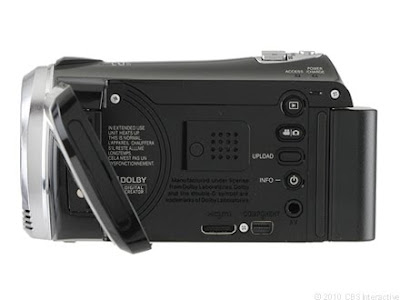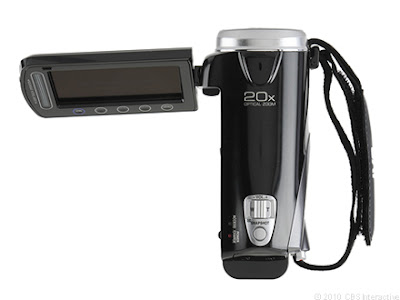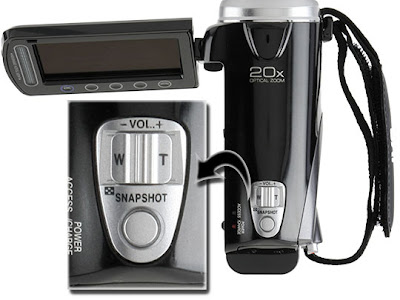JVC Everio GZ-HM320
Friday, 16 July 2010
Leave a Comment
The good: Relatively intelligent autofocus system; compact.
The bad: Poor video quality; no optical image stabilization.
The bottom line: The four sibling models--the JVC Everio GZ-HM300, HM320, HM340, and HD500--deliver subpar video for even their dirt-cheap prices.
With some of the worst video quality I've seen in an HD camcorder of late, the best I can say about JVC's entry-level HD Everio camcorder models is that they're small and cheap. Though they're $60 to $100 less than HD competitors, they're defined by a tiny, insufficient-resolution-for-HD sensor, a 20x zoom lens with no optical image stabilization (only electronic), and the lowest-resolution LCD display in their class.Perhaps JVC's goal is to upsell customers: the company offers 10 HD models for less than $800, with these four nearly identical versions that list between $400 and $550 alone. Three are flash models that differ only by built-in memory, and the fourth is an 80GB hard-disk-based model, which takes microSD cards instead of regular SDHC/SDXC cards. It bears pointing out that in JVC's confusing lineup and unlike every other manufacturer out there, the similarly named HD300 and HD320 are not sibling products to the HM300 and HM320; they have bigger, higher-resolution sensors and their flash-based sibling is the HM200.
One thing the entry-level JVC models do have going for them is size: they're the lightest and smallest models in their class. The length of the body of the flash models is about the width of a large man's palm; the hard-drive version is slightly longer and wider, which might make for more comfortable shooting for large-handed people. Though made of shiny plastic, the camcorder feels reasonably well constructed.Beneath a door on the bottom right sits a pair of SDHC card slots; the models with built-in memory only have a single slot. I like this card location better than in most of the other designs I've seen; it's out of the way and the thin grip strap doesn't block it. I also like the location of the USB connector, which shares a spot above the battery with the DC input.
Toward the front of the camcorder is the grip strap release lever, which turns it into a wrist strap. The top controls consist of the zoom switch and photo shutter button.
The LCD recess houses the playback and recording controls, Upload (to YouTube, via computer), and a power button that also cycles through three different information screens. I'm not a big fan of the multiple-duty power button; to me, it's a surefire way to end up turning off the camcorder accidentally. The component, AV, and Mini-HDMI out connectors also occupy the recess.
Of the touch-sensitive buttons on the LCD bezel, only OK and Menu are fixed; the other three are context sensitive. You navigate the menus via a slider strip on the left side, which lights up as you use it. It probably demos well in retail and gives you something pretty to look at while the camcorder boots, but it's only modestly effective as a navigation technique--it's too imprecise for that or for manual focus, leading to accidental slide-bys past your desired options.
The feature set is pretty typical. Most notably, there's face-priority AE/AF, video categorizing, interesting time-lapse video, and a faux motion-sensor mode that records when it detects changes in brightness.
Unfortunately, none of these makes up for the lack of optical image stabilization. JVC fails to distinguish between optical and electronic stabilization (EIS) on its Web site, referring to both as the "Advanced Image Stabilizer," but the HM300/320 manual refers to it as the "digital image stabilizer." Unfortunately, EIS can degrade video quality, and the camcorder simply doesn't have the extra pixels to spare for the EIS to work well.
On the upside, the autofocus works pretty intelligently, and seems to make accurate distinctions between subject and background without notable delays. And the 1,400mAh battery last a reasonably long time, somewhere between 60 and 90 minutes.
Which brings me to video quality. Though I don't expect much for $300, I admit I'm probably dinging JVC just a little harder for marketing this as an HD camcorder when it's adhering to the letter but not the spirit of the definition of HD (Canon plays the same game with its HF R series). The sensor is tiny and its native resolution is somewhat mysterious. It varies with the zoom, which is yet another trick that annoys me; it's a now-common method for gaming the zoom ranges on camcorder lenses, but it's only potentially acceptable as long as the effective number of pixels is still above the minimum needed to get a native HD capture, about 2.1 megapixels. But the HM300/320/340 and HD500's effective resolution ranges from 1.1 megapixels down to 750,000 pixels, which the camcorders then interpolate up to 1920x1080 HD.
If you're going to be playing the video at small sizes--say, 50 percent or less--it should look fine and sharp. At actual size, though, the subject is soft, and both edges and out-of-focus areas look quite smeary and processed. You can get the same results out of a cheaper standard-definition model. That's coupled with a lens that produces uncommonly bad fringing; my videos contained not just rampant purple, but yellow, cyan, and magenta variations.
However, the colors are pleasing and saturated, if not accurate, and like most low-end camcorders, the highlights tend to blow out. The sound is just OK; the mics seem oddly omnidirectional given their placement beneath the lens, and I suspect that location makes them a bit more susceptible to wind noise, the digital wind filter notwithstanding. Still, the sound is clear, if tinny.
The low-light video looks surprisingly decent, as long as you play it back scaled down. At full size it's pretty soft and noisy.
Though $300 sounds cheap for an HD camcorder, if by choice or budgetary necessity you're willing to sacrifice video quality, you might as well spend even less for a decent standard-definition model. Otherwise, I suggest you spend a little more for a true HD model like the Panasonic HDC-SD60. Of the four JVC options, only whichever is cheapest at the moment is even worth considering, and the HD500 is simply overpriced.
The bad: Poor video quality; no optical image stabilization.
The bottom line: The four sibling models--the JVC Everio GZ-HM300, HM320, HM340, and HD500--deliver subpar video for even their dirt-cheap prices.
 |  |  |  |
With some of the worst video quality I've seen in an HD camcorder of late, the best I can say about JVC's entry-level HD Everio camcorder models is that they're small and cheap. Though they're $60 to $100 less than HD competitors, they're defined by a tiny, insufficient-resolution-for-HD sensor, a 20x zoom lens with no optical image stabilization (only electronic), and the lowest-resolution LCD display in their class.Perhaps JVC's goal is to upsell customers: the company offers 10 HD models for less than $800, with these four nearly identical versions that list between $400 and $550 alone. Three are flash models that differ only by built-in memory, and the fourth is an 80GB hard-disk-based model, which takes microSD cards instead of regular SDHC/SDXC cards. It bears pointing out that in JVC's confusing lineup and unlike every other manufacturer out there, the similarly named HD300 and HD320 are not sibling products to the HM300 and HM320; they have bigger, higher-resolution sensors and their flash-based sibling is the HM200.
| JVC Everio GZ-HM300/HM320/HM340 | JVC Everio GZ-HD500 | JVC Everio GZ-HM200 | JVC Everio GZ-HD300/HD320 | JVC Everio GZ-HD620 | |
| Sensor | 1.37-megapixel CMOS | 1.37-megapixel CMOS | 3.1-megapixel CMOS | 3.1-megapixel CMOS | 3.3-megapixel BIS CMOS |
| 1/5.8 inch | 1/5.8 inch | 1/4.1 inch | 1/4.1 inch | 1/4 inch | |
| Lens | 20x f1.8-3.5 46.4 to 928mm | 20x f1.8-3.5 46.4 to 928mm | 20x f1.9-3.2 41.4 - 828mm | 20x f1.9-3.2 41.4 - 828mm | 30x f1.8-4.7 43.7 - 1411mm |
| No | No | Yes | Yes | Yes | |
| Min illumination (lux) | n/a | n/a | n/a | n/a | n/a |
| No | No | No | No | No | |
| LCD | 2.7-inch 123,000-dot | 2.7-inch 123,000-dot | 2.7-inch 123,000-dot | 2.7-inch 123,000-dot | 2.7-inch 123,000-dot |
| Primary media | 0GB/8GB/16GB flash; SDHC | 80GB hard disk; microSD | 0GB flash; SDHC | 60GB/120GB hard disk; microSD | 120GB hard disk; microSD |
| HD recording | AVCHD: 1080/60i @ 24, 17, 12, 5 Mbps (all video interpolated up from less than 1,440x1,080 pixels; actual dimensions n/a) | AVCHD: 1080/60i @ 24, 17, 12, 5 Mbps (all video interpolated up from less than 1,440x1,080 pixels; actual dimensions n/a) | AVCHD: 1080/60i @ 24, 17, 12, 5 Mbps | AVCHD: 1080/60i @ 24, 17, 12, 5 Mbps | AVCHD: 1080/60i @ 24, 17, 12, 5 Mbps |
| Manual shutter speed and iris | No | No | No | No | Yes |
| Accessory shoe | No | No | No | No | No |
| Audio | 2 channels | 2 channels | 2 channels | 2 channels, headphone | 2 channels |
| Body dimensions (WHD, inches) | 2.1 x 2.4 x 4.4 | 2.1 x 2.5 x 4.6 | 2.2 x 2.6 x 4.4 | 2.1 x 2.7 x 4.5 | 2.1 x 2.5 x 4.6 |
| Operating weight (ounces) | 8.5 | 10.7 (est) | 11 (est) | 12.8 (est) | 11 (est) |
| Mfr. Price | $399.95/$449.95/$499.95 | $549.95 | $579.95 | $699.95/$799.95 | $649.95 |
| Ship date | February 2010 | March 2010 | March 2010 | March 2010 | April 2010 |
Toward the front of the camcorder is the grip strap release lever, which turns it into a wrist strap. The top controls consist of the zoom switch and photo shutter button.
The LCD recess houses the playback and recording controls, Upload (to YouTube, via computer), and a power button that also cycles through three different information screens. I'm not a big fan of the multiple-duty power button; to me, it's a surefire way to end up turning off the camcorder accidentally. The component, AV, and Mini-HDMI out connectors also occupy the recess.
Of the touch-sensitive buttons on the LCD bezel, only OK and Menu are fixed; the other three are context sensitive. You navigate the menus via a slider strip on the left side, which lights up as you use it. It probably demos well in retail and gives you something pretty to look at while the camcorder boots, but it's only modestly effective as a navigation technique--it's too imprecise for that or for manual focus, leading to accidental slide-bys past your desired options.
| Canon HF R100/ 10 / 11 | JVC Everio GZ-HM300/HM320/HM340 | Panasonic HDC-SD60/ TM55 / TM60 | Sony Handycam HDR-CX110/CX150 | |
| Sensor | 2.4-megapixel CMOS | 1.37-megapixel CMOS | 3-megapixel CMOS | 3-megapixel Exmor R CMOS |
| 1/5.5 inch | 1/5.8 inch | 1/4.1 inch | 1/4 inch | |
| Lens | 20x f1.8-3.6 40 - 800mm (16:9) | 20x f1.8-3.5 46.4 to 928mm (n/a) | 25x f1.8-3.3 35.7-893mm (16:9) | 25x f1.8-2.6 37 - 1075mm (16:9) |
| Optical image stabilization | Yes | No | Yes | Yes |
| Min illumination (lux) | standard: 5.5 low light: 0.4 | n/a | recommended:1400 low light: 4 night: 1 | standard: 11 low light: 3 |
| No | No | No | No | |
| LCD | 2.7-inch 211,000-dot | 2.7-inch 123,000-dot | 2.7-inch 230,400 dot touch screen | 2.7-inch 230,000-dot touch screen |
| Primary media | 0GB/8GB/32GB flash; SDHC | 0GB/8GB/16GB flash; SDHC | 0GB/8GB/16GB built-in; SDXC | 0GB/16GB built-in; SDHC |
| HD recording | MPEG-4: 1080/60i @ 24 Mbps; 1,440x1,080/60i @ 12, 7, 5 Mbps (all video interpolated up from 1,664 x 936) | AVCHD: 1080/60i @ 24, 17, 12, 5 Mbps (all video interpolated up from less than 1440x1080; actual dimensions n/a) | AVCHD: 1080/60i @ 17, 13, 9; 1,440x1,080/60i @ 5 Mbps | AVCHD: 1080/60i @ 24, 17Mbps; 1,440x1,080/60i @ 9,5 Mbps |
| Manual shutter speed and iris | No | No | Yes | No |
| Accessory shoe | No | No | No | No |
| Audio | 2 channels; mic, headphone jacks | 2 channels | 2 channels | 2 channels |
| Body dimensions (WHD, inches) | 2.4 x 2.5 x 4.9 | 2.1 x 2.4 x 4.4 | 2.0 x 2.6 x 4.4 | 2.0 x 2.3 x 4.3 |
| Operating weight (ounces) | 10.9 (est) | 8.5 | 10.5 | 9.3 |
| Mfr. Price | $499.99/$549.99/$699.99 | $399.95/$449.95/$499.95 | $499.95/$529.95/$499 | $499.99/$549.99 |
| Ship date | March 2010 | February 2010 | March 2010 | February 2010 |
The feature set is pretty typical. Most notably, there's face-priority AE/AF, video categorizing, interesting time-lapse video, and a faux motion-sensor mode that records when it detects changes in brightness.
Unfortunately, none of these makes up for the lack of optical image stabilization. JVC fails to distinguish between optical and electronic stabilization (EIS) on its Web site, referring to both as the "Advanced Image Stabilizer," but the HM300/320 manual refers to it as the "digital image stabilizer." Unfortunately, EIS can degrade video quality, and the camcorder simply doesn't have the extra pixels to spare for the EIS to work well.
On the upside, the autofocus works pretty intelligently, and seems to make accurate distinctions between subject and background without notable delays. And the 1,400mAh battery last a reasonably long time, somewhere between 60 and 90 minutes.
Which brings me to video quality. Though I don't expect much for $300, I admit I'm probably dinging JVC just a little harder for marketing this as an HD camcorder when it's adhering to the letter but not the spirit of the definition of HD (Canon plays the same game with its HF R series). The sensor is tiny and its native resolution is somewhat mysterious. It varies with the zoom, which is yet another trick that annoys me; it's a now-common method for gaming the zoom ranges on camcorder lenses, but it's only potentially acceptable as long as the effective number of pixels is still above the minimum needed to get a native HD capture, about 2.1 megapixels. But the HM300/320/340 and HD500's effective resolution ranges from 1.1 megapixels down to 750,000 pixels, which the camcorders then interpolate up to 1920x1080 HD.
If you're going to be playing the video at small sizes--say, 50 percent or less--it should look fine and sharp. At actual size, though, the subject is soft, and both edges and out-of-focus areas look quite smeary and processed. You can get the same results out of a cheaper standard-definition model. That's coupled with a lens that produces uncommonly bad fringing; my videos contained not just rampant purple, but yellow, cyan, and magenta variations.
However, the colors are pleasing and saturated, if not accurate, and like most low-end camcorders, the highlights tend to blow out. The sound is just OK; the mics seem oddly omnidirectional given their placement beneath the lens, and I suspect that location makes them a bit more susceptible to wind noise, the digital wind filter notwithstanding. Still, the sound is clear, if tinny.
The low-light video looks surprisingly decent, as long as you play it back scaled down. At full size it's pretty soft and noisy.
Though $300 sounds cheap for an HD camcorder, if by choice or budgetary necessity you're willing to sacrifice video quality, you might as well spend even less for a decent standard-definition model. Otherwise, I suggest you spend a little more for a true HD model like the Panasonic HDC-SD60. Of the four JVC options, only whichever is cheapest at the moment is even worth considering, and the HD500 is simply overpriced.
0 comments »
Leave your response!